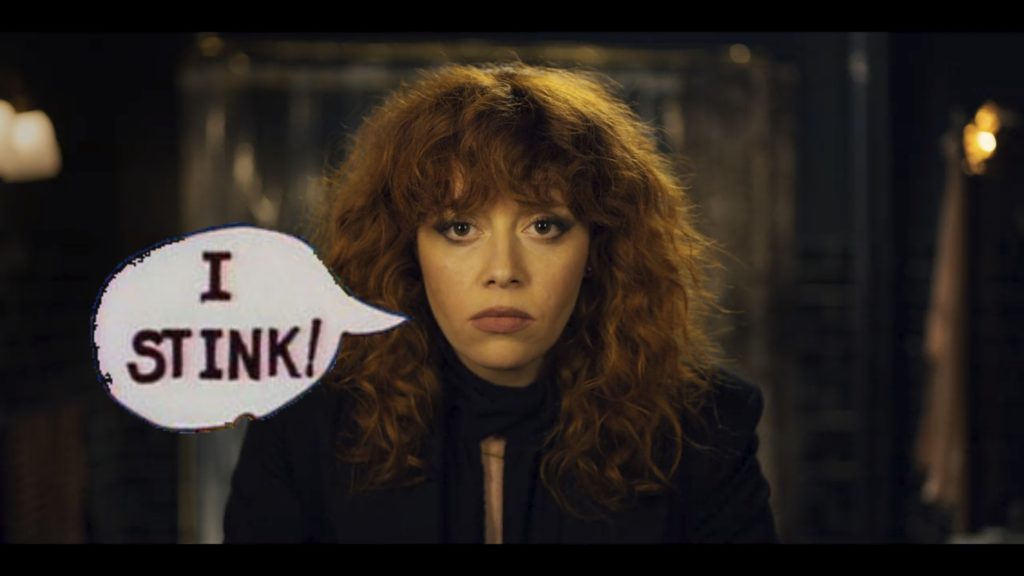
Netflix Originals, from what I’ve seen, are almost uniformly mediocre. Full disclosure: I have definitely watched far fewer of these things than you (“you” is almost everyone alive right now, I think) and have given up on most after one or two episodes, but the same below-average stink rises from everything I’ve seen and, in discussing Netflix series with those who have watched a good lot of them, I find, even though folks willingly binge these things all the way through, once finished they commonly assess them as no more than “fine” or “not bad” (that is when they’re not claiming they’re the best things ever made–for like a week).
In other words, I’m basing the following on very little and, as I don’t REALLY want to make this an extensive takedown of Netflix because that would take a lot of work and force me to watch a lot more of their shows, I’m going to just shit an opinion half-assedly out into the web, much like Netflix does with their Originals.
My basic theory is that, in gearing their output around full seasons of shows meant, by the company’s own marketing, to be binge-watched, Netflix has altered television, both in how creators create it and consumers consume it. Netflix Originals are focused more on the big picture (the season), rather than individual episodes and so, while a season may have its fair share of climactic, memorable moments scattered throughout–stuff that will stick in the viewer’s mind as what defines the series and which will allow them to come away from it feeling they had a satisfactory time–episodes rarely stand out on their own and an analysis of moment-to-moment details uncovers an overall lack of care and attention, bringing down the fundamental quality of the entire production.
One illustration of this I often return to is the way Netflix episode lengths fluctuate, sometimes coming in around the 20-minute mark, other times ballooning up to a full half-hour. You might argue this means creators are, in fact, putting a lot of care into individual episodes, giving each enough time to be fully fleshed out, but I believe it proves the opposite. As far as comedy TV goes, on most networks the standard is a maximum of 22 minutes per episode. While this is in no way a perfect runtime as it’s been arbitrarily reached thanks to the plague of ever-greedier advertising space, a locked-in runtime of some length is one limitation that forces creators to polish their work down to the very best bits, so that they aren’t just flabby, boring things that I hate. (I know they air reruns of Bojack Horseman on Comedy Central now; do those get cut to fit runtime standards? And, if so, do the Comedy Central versions make the show good?)
Another very easy example of how Netflix serieses clearly care more about season over episode is the pilot of the show Love, starring Gillian Jacobs, who I love because of Community, a show that cranked out 22-minute pearls week after week on network TV and then moved to the internet where the episodes clocked in at random lengths and dragged the comedy way down (okay, Community had much bigger troubles before this happened but I just wanted to take the opportunity to obnoxiously hammer home my point about runtimes, thanks). Love begins with a pilot that’s all setup and ends on a cliffhanger: the lives of the two lead characters, who have been disparate for the whole of the pilot, are now going to converge.
Now, you might notice this is not what a cliffhanger actually is because a cliffhanger builds us up to expect something shocking or amazing the next time we tune in, but the cliffhanger of the pilot of Love is “tune in next time to find out what the core character dynamic of our show is going to be.” It’s a boring pilot that lost my interest, but the second episode, in which I actually understood what the fuck the series was going to be, was a lot better. I still didn’t watch anymore after that though because they’d wasted enough of my time already.
But I digress! As I said, I’m not going to try to explore this theory much beyond the tiny Russian Doll example mentioned in my title that you are looking forward to me getting around to (I am good at cliffhangers, just like the Netflix Original, Love). My evidence is neither extensive nor concrete, but I’m still probably right, fuck you. Netflix Originals are designed with seasons, not episodes, in the forefront of the creators’ minds. And you, the dumbass viewer, are being trained to view television this way as well.
I mean, it’s sort of obvious, no? It’s difficult to binge upwards of three hours of stuff (you all need more hobbies) and then go back over it to pick out the best swatches. More likely than not, the entire show will register in your noggin as a shit mélange and you’ll struggle to recall standout episodes, let alone moments (again, deliberately climactic sequences will register fine; I’m sure you’ll remember, for example, the finale). To wit, I rarely hear people talk about specific episodes of Netflix shows because that’s not how they absorb them. And even if you did mete out your consumption of a Netflix series, that’s not how they’re made to be watched. As I just explained with the Love example, there’s nothing too satisfying about watching one episode. You gotta be in it for the long run, to get the full impact of disappointment.
Incidentally, as someone who sometimes gets paid money to write about TV shows, I was once obligated to analyze an entire Netflix series, Matt Groening’s Disenchantment, episode by episode. It was an unfortunate time for me as I gradually came to the realization I was going to have to find ten unique ways to say “it’s not funny but the score is great, the plotting is okay, and the art looks really nice except for when it looks cheap and shitty instead.” (I know, nobody loved Disenchantment, but my point still stands that individual episodes of Netflix series have little identity of their own.)
Side note: I am talking exclusively about Netflix Original SERIES. My criticisms do not extend to their original films, partially because I’ve only seen one (Roma, which was pretty good) but also because Netflix’s film projects seem to be those they get actual auteurs involved with (you know, like Adam Sandler) and funnel enough money into so they look polished and unique so that if it’s animation it doesn’t look like a Newgrounds’ cartoon for a change and if it’s live-action and there’s a bar scene, they don’t have to reuse the same goddamned bar in Manhattan they appear to use for all their shows. (David Fincher-directed stuff on Netflix, by the way, is also an exception because that guy doesn’t really do unpolished.)
The best TV series going, Better Call Saul (which, yes, I know, is co-produced by Netflix now, but it’s not a proper Netflix Original), does, like good television should, season-long arcs as well as episodes that are beautifully-constructed short films in isolation (all of which, I might add, come in at roughly the same runtime). Better Call Saul is a show in the modern era that I can reflect on and cite individual episodes as my favorites (my favorite from last season was “Something Beautiful,” which had the amazing Hummel-stealing sequence and the bit where Jimmy reads Chuck’s letter). What’s your fave ep of Russian Doll? You don’t have one, you fucking liar.
I’m not saying you can necessarily jump into any episode of Better Call Saul; the season-long arcs are important. However, the rising and falling sense of drama, the climaxes, all the good shit that makes a solid story, is happening within each episode, as well as over the course of the season.
Maychance a counterargument you have is that, well, Netflix is just doing it differently; they’re not making shows, they’re making long-ass, multi-part films. Well, then, number one, you’re agreeing with me that it’s about the season, not the episodes and, number two, no they aren’t, fuck off. I refuse to believe so many different shows on Netflix are pulling some avant garde Twin Peaks: The Return shit. You have to be a goddamn auteur to pull some shit like that off. Nobody making a Netflix show is David Kellogg’s Lynch (note: I wrote this well before Netflix announced they are in fact producing a series by David Kellogg’s Lynch). They’re just people focused on a season-long arc while still trying to make separate episodes, but doing a sloppy job of it. If it’s really one long movie, and your name isn’t David Kickin’ Lynch, then just put it online as a four-hour long goddamn movie, why don’t you, coward?
If something else you might be goofy enough to suggest is that this season-focused style television is exclusive to Netflix and that it is not changing the overall television landscape, then it’s cool that you’re so wrong all the time, doofus! It might be only Netflix doing this right now, I don’t honestly know, but they are such a juggernaut in the television industry, releasing so many shows so regularly, that a huge amount (if not the bulk) of what people consume and discuss re: the world of television IS Netflix programming. In other words, we can’t separate Netflix from “the rest of television” because they ARE television or at least a big, fat, below-average chunk of it.
Anyhow, what was I talking about? Oh yeah, Russian Doll blows. I’ve seen the first two episodes and they were dumb and they blew a big sack of chunks. I am exaggerating a touch here. Maybe it was only a medium-large chunksack. I’ve seen worse Netflix serii, but I saw enough Russian Doll (two of) to get That Netflix Feeling from it.
Let me say in advance that it is not my intent to insinuate Russian Doll‘s below-averageness is in any way to do with its nearly all-female creative staff. I have met two to three females in my life and was an Amy Poehler fan during her Upright Citizens Brigade days. Also, the series at least has the occasional very good joke and the basic conceit feels like a unique-enough take on the Groundhog Day trope and would be the reason I’d see the series through to the end, if I ever felt I had the energy to do so (I don’t think I do though). I’ve definitely seen worse stuff on Netflix that I’m sure was erected exclusively by testosterone. I don’t believe the series is crummy because of women; I believe it’s crummy because of Netflix.
Before I get to the main example I want to harp on (as I wrote this for my personal blog there are no restrictions, just like a Netflix Original), for kicks, I will give a brief rundown of how Russian Doll rubbed me the wrong way in general:
1. Natasha Lyonne is overacting and I cannot stand it. Greta Lee is great, look at Greta Lee and how she’s doing actual acting and is good. Natasha Lyonne is just doing a parody of some 1950s movie gangster mook or something? Unacceptable. (Supposedly she’s basically just playing herself, but I’ve watched interviews with Natasha and I like her a lot more than Nadia.)
2. I hate the way characters randomly devolve into soliloquy-deliverers because the writers wanted to make some very intelligent point about the nature of solitude or whatever the shit. Real people don’t sound like this and, more importantly, the people in Russian Doll don’t even sound like it, until they suddenly do out of nowhere.
3. New York is an over-represented city and I’m sick of seeing it, or at least sick of seeing it represented with such relentless positivity. New York is still cool in a lot of ways and is worth visiting, but it’s also a nearly impossible place to live unless you’re a millionaire and the whole authentic melting pot, artist and poet-friendly vibe that entertainment media still pretends defines the place has been all but bled dry as high rent pushes out all the cool shit in exchange for franchises and faux-rustic eateries that all repurpose their decor from the same industrial yard.
Growing up in NYC and living in the bastard next-door state of New Jersey most of my life, perhaps this is a personal vendetta, but I feel it is not an unfair one. If Russian Doll were the first positive representation of NYC put to digital film, maybe I’d celebrate it for its optimistic perspective, but obviously it is the fuck not. With its fancy apartments and charming, friendly characters around every street corner, it smacks very much of being written by liberal rich people who have NYC in their minds as a haven for hip, sex-positive people to have a good time all the time when, in reality, it’s just really fucking hard to successfully live there.
4. “Record player” is a stupid lifelong code word for someone born in the eighties who might have cause to bring up record players in conversation at some point. Why not, like, “purple record player?”
AND NOW THE MAIN EVENT!!!!!!!!!!!!! Very exciting.
In the first episode of Russian Doll, we open on a shot of our protagonist, Nadia, staring directly into the camera at me, the viewer! We then get a close-up of her hand turning off the sink faucet. We cut to a wide profile shot showing us that Nadia is in a fancy-looking bathroom. We cut back to the shot of Nadia’s face. She turns to look at the door behind her (someone is knocking on it). We cut to the door which is a very unique door because it’s emblazoned with some sort of neon-blue vagina. We then cut back to the profile shot (though Nadia has now turned toward us) and Nadia steps forward. We cut again to the vagina door as we follow Nadia’s approach to it.
We then cut to this very memorable close-up of Nadia’s hand grasping the door handle.
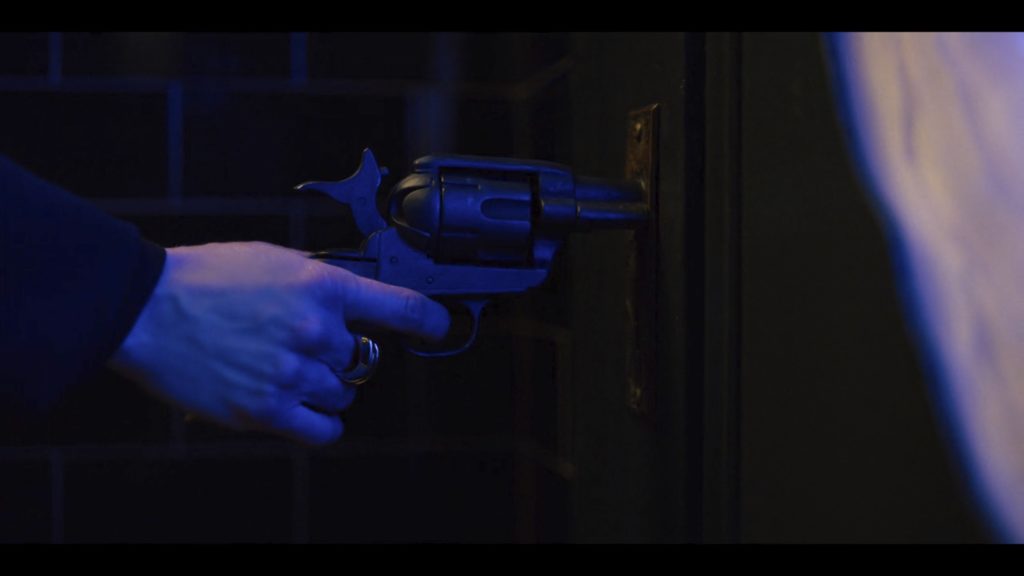
It’s very memorable because it’s shaped like a gun and most door handles are not shaped like guns.
A little under 10 minutes into the episode, Nadia is struck by a car and killed. We cut from the shot of her dead face to her, very much alive again, and back in the bathroom. After a bit of confused looking around and straightening up, she walks out of the bathroom and, as she exits through the vagina door, we get a shot that looks like this:
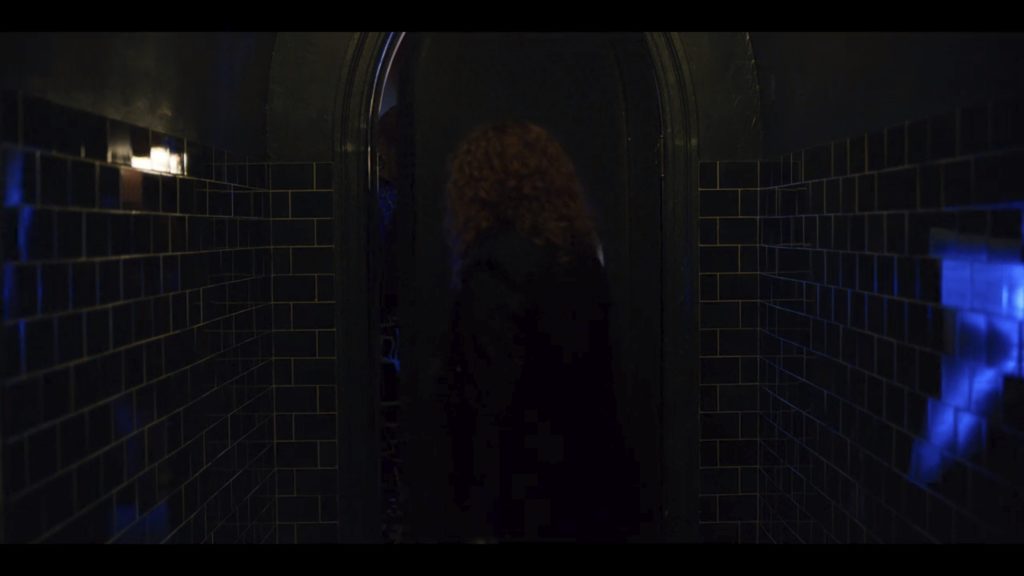
Actually, I said we get a shot, but that’s not accurate because, unlike last time with the close-up of the gun handle, there’s no cut whatsoever. We just follow Nadia from behind, not cutting until she exits through the doorway.
Maybe you’ve already intuited what I’m getting at, but if not, here’s why I hate this shoddy fucking garbage a whole lot.
This series is about repetition. It’s this series’ job to be repetitive. Its job. Its job. Repetitiveness is its job. And while, sure, the repetition theme gets spelled out for you shortly after through dialogue, the point of making something in an audiovisual medium is that you use every tool available to communicate your art. We shouldn’t just get your premise on a basic level; we should FEEL the repetition! We should be right there along with Nadia, feeling as though we’ve done this all before, beat by beat.
I’m not saying the scene should be an exact replication because, obviously, Nadia has some sense she’s done this all before so she’s going to react differently to it, but it is still important to drive home that sense of monotony.
Let’s look at how to better handle this kind of scene. I have randomly selected the film Groundhog Day as an illustration.
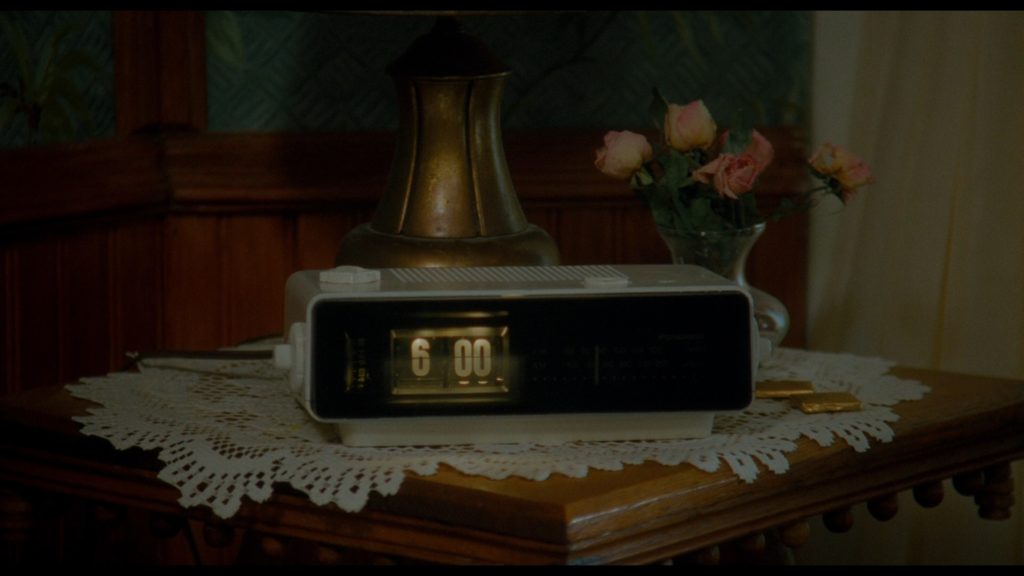
The first two times Phil Connors wakes up on the same day, we begin with this shot of his clock ticking over from 5:59 to 6:00, followed by a very slow pull back to Phil lying in bed. In this fucking way, even without any real character involvement, the movement of the camera has communicated a sense of repetition.
Phil looks like this the first time:
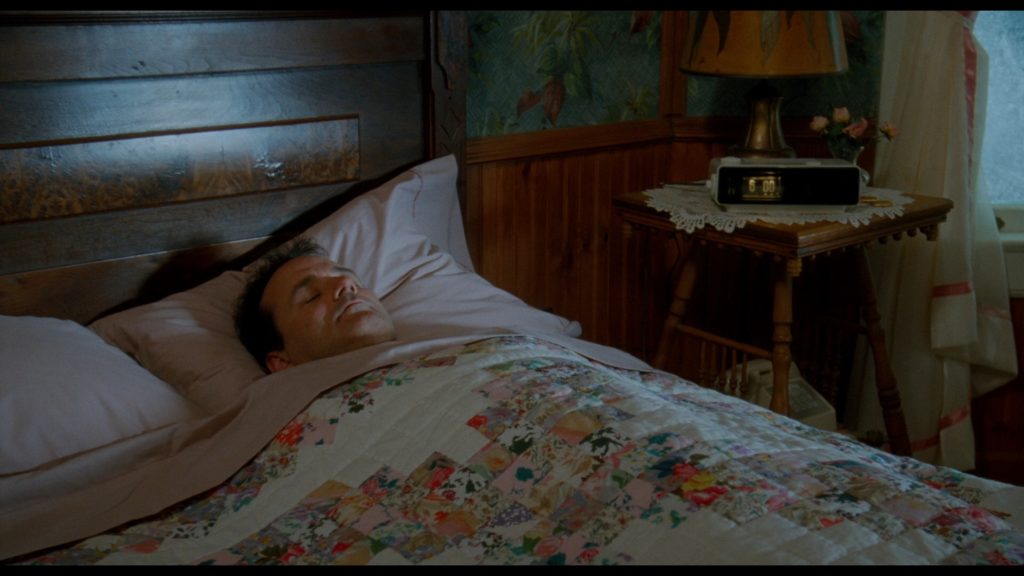
And like this the second time:
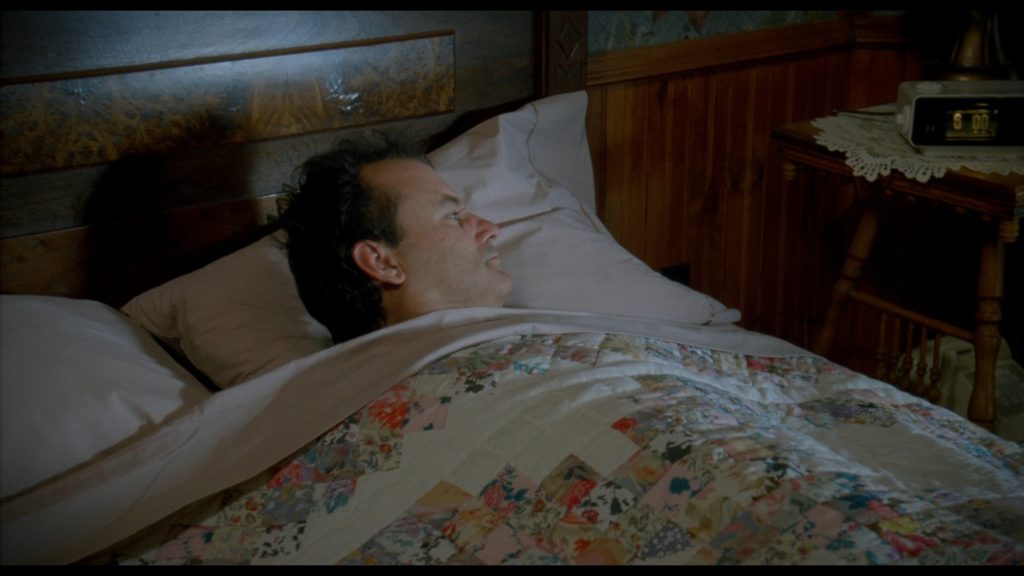
This is because he is behaving like a character in his situation should, noticing that the radio seems to be playing the exact same thing it was yesterday. So it’s not exactly the same! In fact, the framing of the shot is even somewhat different, but the point is enough work was done here to make the moment feel almost exactly the same both times.
The scene continues to progress in more or less the same fashion as it did previously. We follow Phil as he gets up, splashes water on his face in the bathroom, and then follow him as he goes over to the window and looks out. Again, Phil’s behavior is not identical but the camera and order of shots is nearly the same.




Note I said the order of shots is nearly the same because, the second time, before we get the shot of the street seen from Phil’s window, we get one extra cut to him looking out the window because, from his face, we can see he’s looking out specifically to figure out what the hell is going on:

At the end of the scene, we also get one new cut to him facing away from the window in confusion. These two new cuts work because they don’t alter things too drastically. There is still an overall feeling of repetition but these two new cuts create a subtle variation on it which indicates that, although this is the same situation happening over again, for Phil the repetition is a new and bewildering experience.
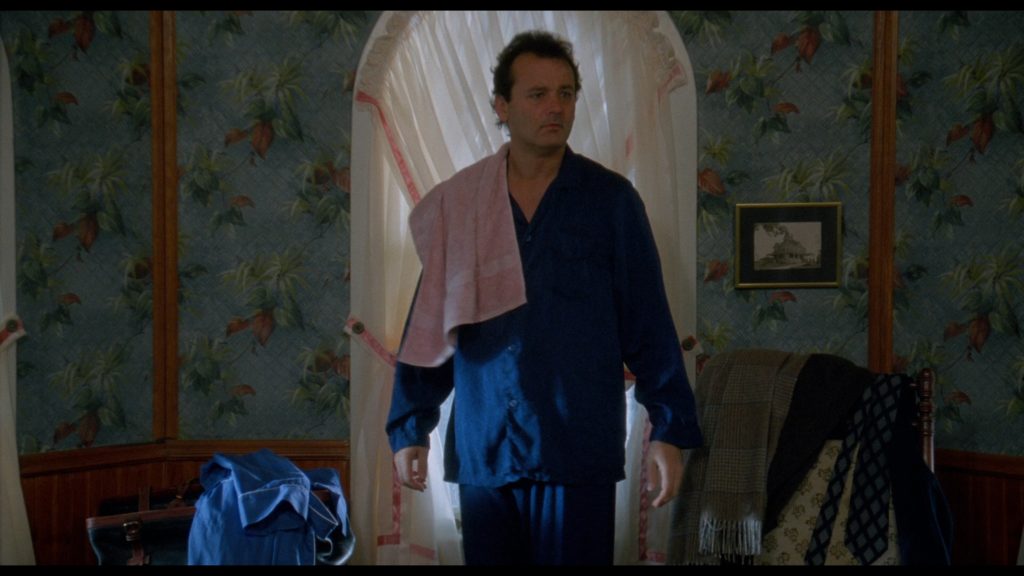
With Russian Doll, because I was so struck by the omission of the gun handle the second time Nadia ends up in the bathroom, I initially glossed over the rest of the sequence. But guess what! If you analyze it more deeply, they fuck it up on pretty much every level! You could use my argument that the second time is so different because, just like Groundhog Day, it’s a variation on the first to mirror Nadia’s experience, but the problem is Russian Doll makes barely any effort to establish the sense that this has all happened before, so there’s no subtle variations. In terms of shot composition and pacing, just about EVERYthing is different.
The scene starts, not with Nadia’s face looking at us, but with the vagina door. Nadia turns off the water like she did the first time, but it happens in profile; there’s no close-up of the faucet like we got the first time around. And then we get a shot from behind her head, after which she turns around and it looks like this:
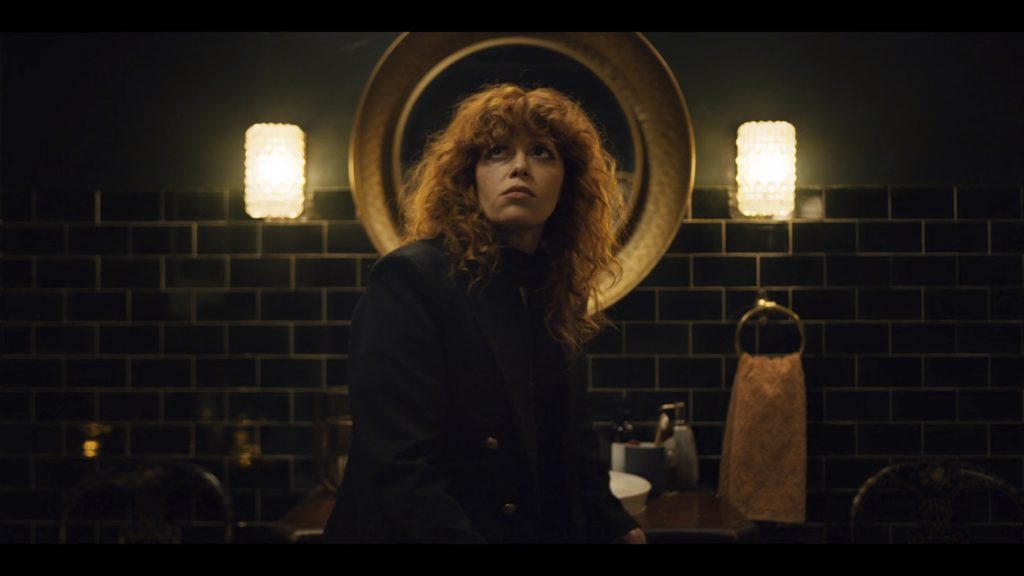
This shot, which feels not unlike Phil’s turn away from the window, is arguably even worse than the gun handle close-up because, unlike in Groundhog Day where we got a shot of Phil’s back as he looked out the window both times, WE NEVER GOT THIS SHOT OF NADIA AT ALL THE FIRST TIME. We got Nadia’s face, the vagina door, and a profile shot. We NEVER saw the bathroom from this angle.
And, look, I get what they’re doing here. When she turns around, the mirror frames her head in such a way as to create a halo, as if to say “ah, she has been through death,” implying that someone on the crew paid attention to, if nothing else, the stuff in film school about staging shots to achieve symbolism.
But I don’t care! Because the fact of the matter is they could still have both things! There are a number of ways to do this, but here’s one easy fix: since the halo concept isn’t really communicated so well until we see her face framed by the mirror behind it, the first time, include the shot of the back of her head, but don’t have her turn around! If it’s super important to you to not have her head halo-ized at all the first time? Then have her stand slightly off-center! Or with her head down by the sink, splashing water on her face, Phil Connors-style! Your cutesy symbolic shot should not come at the expense of establishing your theme and communicating the core conceit of your entire fucking TV show, not just in the writing but in the direction, editing, and sound!
Ah, but Joe, they DO communicate the repetition concept through sound. Yeah, sort of, except they fuck that up too! Yes, Nadia’s rebirth starts just as the series initially did with the sounds of knocking coupled with a faint, thumping party beat in the background. However, in the opening scene, the moment Nadia opens the bathroom door, the thumping party beat is replaced with the shitty Harry Nilsson pop song “Gotta Get Up.” The second time, we’ve only been in the bathroom several seconds before “Gotta Get Up” starts playing. WHA! HUH! SMUH! Why does your show about repetition fail so badly at repeating stuff? (I hardly think I need mention that Groundhog Day drives the aural repetition home every time by having the clock radio play “I Got You Babe” followed by always-identical inane DJ banter).
I also get that, visually, they went with the vagina door as their grounding image to let you know the night is repeating. The first cut after the close-up of Nadia’s dead face lying against the road is to a shot of the vagina door. BUT WHY THEN WASN’T THAT THE FIRST SHOT OF THE WHOLE SHOW INSTEAD OF NADIA’S FACE STARING AT US? WHY NOT MAINTAIN THE CUT ORDER? WHY DIDN’T YOU MAKE THE FIRST SHOT OF THE SHOW THE VAGINA DOOR? IT’S AN INTERESTING OPENING SHOT?? OR ALTERNATIVELY KEEP NADIA’S FACE AS THE FIRST SHOT OF THE SHOW AND THEN LATER CUT FROM NADIA’S DEAD FACE TO HER ALIVE ONE! THAT WORKS TOO! ALL THESE THINGS WORK AND ESTABLISH THE REPETITION LOOP ALL THE BETTER.
FurtherFUCKINGmore, if you wanted the unique vagina door to be the grounding image, why did you ALSO include the unique gun handle? And then you’ve got the eye-catching halo mirror too! I get it! It’s a funky-looking bathroom! So then why not honor your goddam set designers and clearly feature all of this stuff both the first and second times so that we are better oriented?
Or otherwise JUST PICK ONE! JUST KEEP THE VAGINA DOOR AND THROW THE REST OUT. HOW COME LATER ON WHEN THERE’S A MONTAGE OF NADIA DYING AND BEING REBORN MULTIPLE TIMES YOU USED THE CLOSE-UP OF THE GUN HANDLE AGAIN THERE BUT COULDN’T BE FUCKING BOTHERED THE FIRST TIME SHE CAME BACK TO LIFE? HOW COME THERE’S ACTUAL DIALOGUE ABOUT THE GUN HANDLE LIKE IT’S IMPORTANT?! STOP THROWING HAPHAZARD IMAGERY AT US AND LEARN BASIC CINEMATIC LANGUAGE.
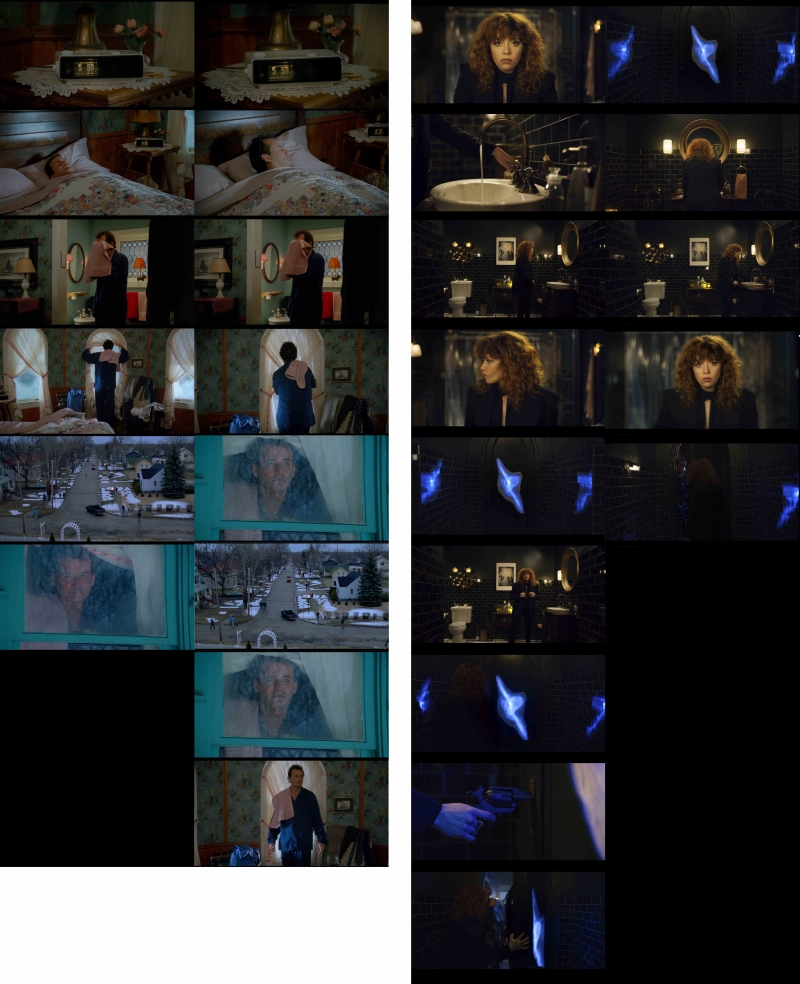
You can start abandoning this stuff as the series progresses and we, along with the protagonist, get into the groove of things, BUT THE FIRST REPETITION SHOULD FEEL TOP TO BOTTOM LIKE A REPETITION. (However, maybe they didn’t want to dedicate too much time to repeating the beats of the opening scene; after all, films have different pacing compared to an episode of television–OH WAIT A SECOND! Netflix shows can be as long they want. 😉 ) This just seems like basic shit to me. It’s obvious editing and direction stuff. The lack of care paid to it renders Russian Doll mediocre on a fundamental level and I believe if you give this degree of attention to most other Netflix Originals, you’ll uncover similar lazy flaws.
And just to reinforce what I’m saying anecdotally, I watched Russian Doll with friends and, though I knew the basic concept of the show going into it and expected Nadia to die at some point and relive the same night again and again, my one friend went in without this knowledge. When he saw Nadia in the bathroom with the halo mirror around her head, he said “where is she?” Yes, we were stoned. And, yes, his memory is terrible! But I still believe his confusion speaks to how the sense of repetition was not communicated.
Repetition is not a difficult thing to pull off in cinema and, as it’s a major theme (if not the theme) of the series, it should be totally and clearly evident. The way this scene was executed says to me that the creators relied on the script to make their repetition gimmick apparent later with little attention paid to reinforcing it with their shots and audio editing. If you aren’t going to make good use of these things, don’t make a fucking TV show or movie then; write a stupid book!
And if you think I’ve gotten a little over-clinical with the shot-by-shot comparison business here, then forget about it! I’m happy to say most of what I’m saying is not necessary, but above all else I’m still left wondering WHY is there a very eye-catching gun handle (especially when there’s already an eye-catching vagina door), WHY is there a close-up of it like it’s important, WHY is it then forgotten, and then WHY is it randomly remembered later in a montage? If the gun close-up had been in there the second time Nadia ended up in the bathroom, I probably wouldn’t have even thought about the rest of this nonsense and you wouldn’t have been ignoring this stupid, massive essay which you have definitely stopped reading by now.
It’s occurred to me that you could argue that Russian Doll smashes through the setup of its concept without a care because we’re all familiar with the Groundhog Day trope by now and who needs their hand held through it, but I don’t think this holds water. For one, though the trope is well-known, I wouldn’t exactly call it overused. But more importantly there’s nothing apparently clever about the way Russian Doll doesn’t bother with the formalities of its premise. Watching this scene, I just can’t come up with anything that amounts to a wink at the audience or any kind of acknowledgement that a deliberate subversion is being executed here. If anything, the shot of Nadia turning around and looking confused is, as mentioned, similar to Phil’s reaction, but that just seems like a straight homage and, because of how it’s employed, it’s a sloppy one!
Russian Doll‘s lack of dedication to details is not a modern, punk rock take on Groundhog Day. It is a not a subversion of cinematic language. The creators of Russian Doll are not David Ketamine Lynch. It’s just laziness. It communicates nothing to me. Actually, it communicates: you’re familiar with Groundhog Day? Well, this is kind of like that. It communicates to me: hey, you already watched the trailer for this, right? You get that it’s a Groundhog Day kind of thing? Okay, cool, we’ll just half-assedly get this bit out of the way then.
Russian Doll says to the viewer: I, Russian Doll, do not have a basic understanding of conventional cinematic language. I do not have my own language. I have a concept which I’ve communicated through the cobbling together of different elements in a way that results in technical functionality, but no overall sense of tone or mood, no confidence of vision, no unique voice. A television show just happens to be the way I ended up telling my story. So… here.
Perhaps owing to a strong, persistent vision executed well, with great attention paid to detail, Groundhog Day is a modern classic. Russian Doll, in contrast, will not live on. Russian Doll will have a short shelf life. Unless they make more seasons of Russian Doll, you’ll be lucky if you remember it after this year as a more recent mediocre Netflix series (or 2, or 800 of them) will take up the space in your brain that once told you you loved Russian Doll.
I started writing this two weeks ago when the web over was gushing about this show and I’m honestly not sure it’s even relevant anymore because nobody’s said boo about the series after like two days of calling it the best thing they’d ever seen. Perhaps that’s the side-effect of an era of endless new content (not to mention the minor distraction of our reality being a living hell), but series that matter live longer; people remember them and quote them and use them as benchmarks to assess other series. Jessica Jones was also the best show ever according to everyone on the internet for about a week (I watched the entire dumbass first season, by the by) and now it’s been canceled and who cares? Like ten people? Remember Stranger Things? Kinda? Sorta? A bit?? You won’t in five years. If that.
Maybe I’m holding TV to absurdly high standards, but why the hell shouldn’t I? Our art is one of the only things we have as a species that has the potential to define us for any lasting period of time and it’s been well-proven that TV can produce incredible art. We have The Wire now. We have Better Call Saul now. We have Twin Peaks, The Simpsons (you know which era I mean), Community, and Arrested Development (before Netflix ruined it). We’re meant to be in the golden age of television, awash in an endless ocean of premium content while Netflix is out here dropping turd after unremarkable turd into it and, like unhealthy, hollow turds do, they float to the top so everyone sees them and then they dominate the conversation (as for film, the ocean/turd metaphor can be applied to Marvel 😀 ).
I don’t expect every show to be a gem, but I expect them to at least try and, on a fundamental level, I don’t believe Netflix shows do. They figure out a story arc for a season, they do the bare minimum to make that arc technically work, and then critics and viewers alike call it the best thing they’ve ever seen that week or otherwise describe it as at least “not bad” or “fine,” so why try harder? After all, that’s why they call it “fine art!” LOL. Thank you. Wow.
If you would like to know, the only Netflix series I enjoyed in full without reservation is The End of the F***ing World.
In conclusion, we still have children concentration camps in the United States, we are currently starting a war in Venezuela because we want more oil, and the climate change crisis has already begun killing people, extincting animal species, and decimating the earth, making all entertainment and any criticism of it completely stupid and frivolous until such time as we sort this utter horror show out. Bye, FUCKERS!
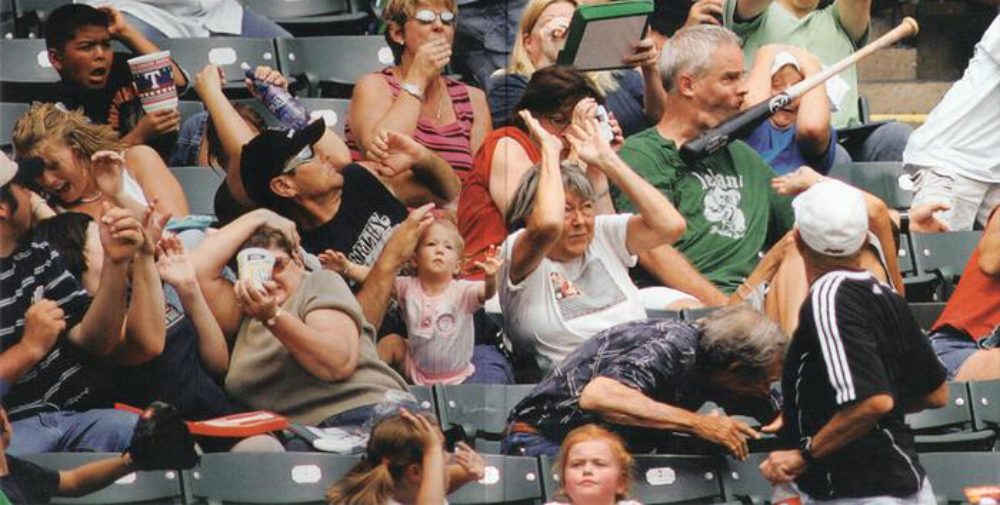
Just say you’re a misogynist and go, good fucking god.
😂